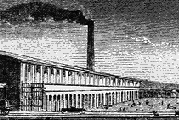|
________________________________________________________ Since it was first outlined, the Harrod-Domar model has gone through a remarkable journey. As repeatedly noted here, there are two concerns: (1) the relationship between the actual and warranted growth rates ("macroeconomic instability") and (2) the relationship between warranted and natural growth rates ("employment instability"). For Harrod, the main theoretical question related to (1), with (2) being relegated largely to a policy concern. Harrod argued that (1) should be welcomed as the first step in a theory of macrofluctuations -- and it was, indeed, upon this suggestion that John Hicks (1949, 1950), Richard Goodwin (1951) and others developed Keynesian business cycle theory. But growth theorists ignored (1) and focused on (2). This change of focus was not altogether misplaced, as we shall see. Joan Robinson called the warranted rate of growth "the element in [Harrod's] exposition which makes it baffling and mysterious." (Robinson, 1949: p.167-8). For instance, she notes that Harrod did not specify precisely why entrepreneurs would change their investment decision only if "expectations" were not met. What, exactly, governs the investment decision? Robinson's question is well-put. Harrod had posited an "adaptable" accelerator theory of investment which effectively establishes that entrepreneurs will be perfectly happy to maintain the same rate of investment as before if their expectations are met, "progress in the current period should be equal to progress in the last preceding period" (Harrod, 1948: p.82). Why this is necessarily so is not made clear by Harrod. His lack of a detailed theory of the investment decision is only partly excused by the fact that he is handling "aggregates" and "averages". Robinson (1949: p.169) also suggests an interesting way of looking at Harrod's account of unemployment. Let us refer to Ld as labor demand, Lf as the labor necessary to operate the capital available at full capacity and Ls as total labor supply. Consequently, there are two types of unemployment at play: the difference (Lf - Ld), which she terms "Keynesian unemployment", as it arises from a deficiency in demand, and the difference (Ls - Lf), which can be termed "Marxian unemployment", denoting the "reserve army of labor". Unemployment caused by the departure of g from gw is Keynesian; unemployment caused by the departure of gw from n is Marxian. It is obvious that in situations such as in Figure 2, where g = gw = n but (YF - Y) > 0, we have permanent unemployment and all of it is of the Marxian type. The question is what happens in such situations? As g = gw, entrepreneurs are evidently happy with their investment decisions. But a pool of unused labor remains. Could they not be absorbed by, say, declining wages and changing the technique of production? And if not, why not? There are a variety of factors considered by Harrod (1948, 1960, 1973) and others which may prevent this. For instance, Richard Kahn (1959) argued that it was possible that real wages would be kept from falling by organized labor -- even if there is a mass of Marxian unemployment, as in Figures 2 and 3. Kahn called such a situation a "Bastard Golden Age". Joan Robinson referred to the situation where g = gw = n and the unemployment gap is zero as the "Golden Age" growth path, "thus indicating that it represents a mythical state of affairs not likely to obtain in any actual economy" (Robinson, 1956: p.99). She referred to a situation where g = gw but the unemployment gap is positive as a "Limping Golden Age", where "the stock of plant has the composition appropriate to the desired rate of accumulation, but there is not enough of it to employ the whole labor force." (Robinson, 1962: p.53). Figure 2, where g = gw = n and (Yf - Y) > 0 is a special case of this. It was on account of concerns like these that Joan Robinson (1956, 1962) and Robert Solow (1956) focused on the adjustment of the warranted rate to the natural rate. In other words, even if we assume actual growth is the warranted rate s/v, we still have an instability between s/v and n. We should emphasize, however, that, for Harrod, the main "knife-edge" was in making actual growth compatible with warranted growth. The subsequent reconciliation of s/v with n was not really considered by Harrod to be a "knife-edge" problem, but merely the identification of the highest potential steady-state growth path, i.e. the steady-state path compatible with full employment. This may help explain why most of the immediate post-Harrod literature was focused so much on obtaining "steady-state" where g = s/v £ n. This is much closer in spirit to Keynesian demand-determined equilibrium because the supply side (i.e. n) is omitted from deterministic importance. Harrodian steady-state growth models with unemployment explicitly built into them were developed by Kahn (1959), Sidney Alexander (1950), Arthur Smithies (1957), James S. Duesenberry (1958) and Joan Robinson (1956, 1962). The models of Evsey Domar (1946, 1947), as we have seen, could also be considered in this light (note that the Domar model presented earlier has no counterpart to the Harrodian "natural rate", and thus no knife-edge over employment equilibrium).
|
All rights reserved, Gonšalo L. Fonseca

